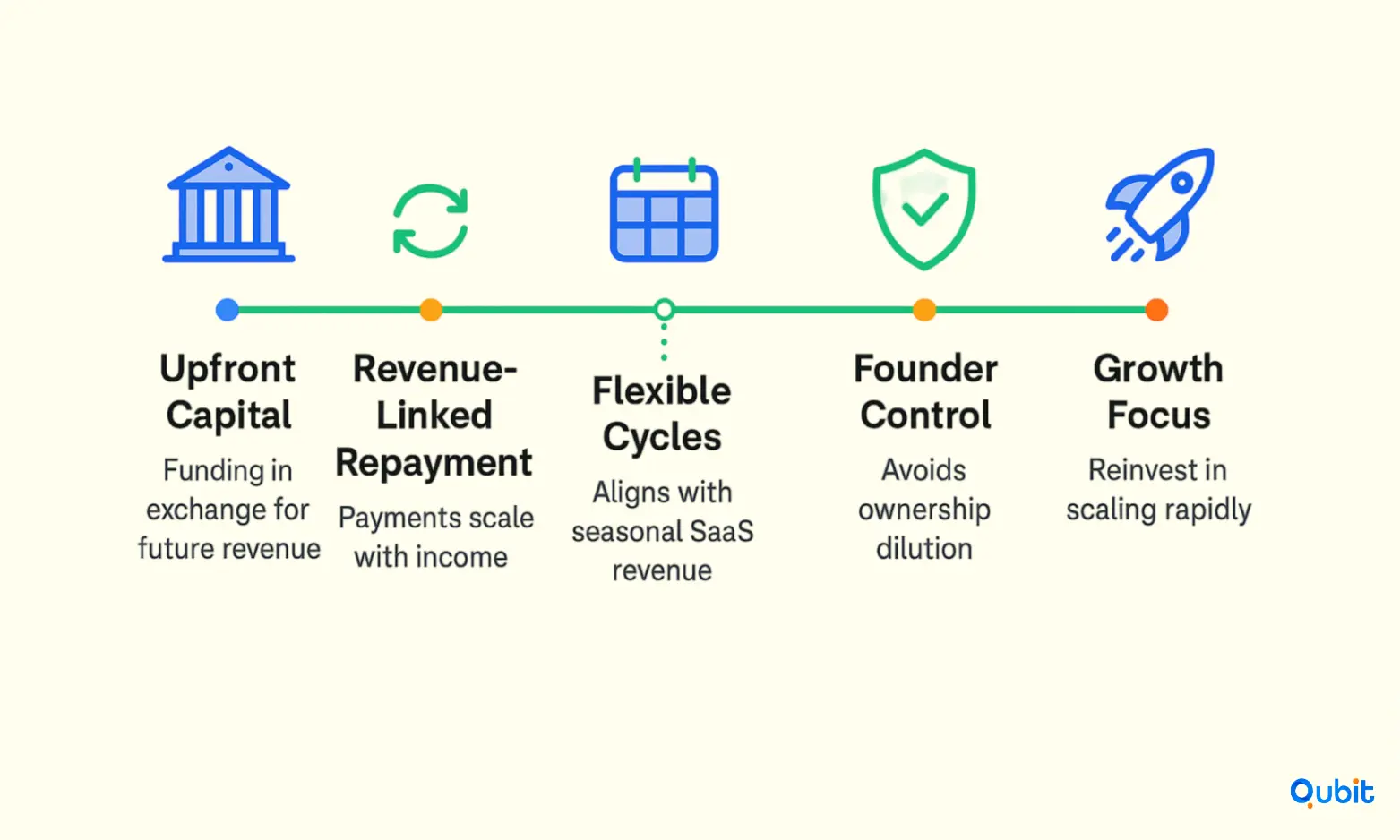The funding landscape for cybersecurity SaaS is shifting fast, and revenue-based financing (RBF) is emerging as a serious alternative to traditional equity rounds. Unlike classic VC, RBF provides non-dilutive capital, so founders can scale while keeping control of their cap table. That flexibility is especially powerful in cybersecurity, where speed, product iteration, and constant reinvestment are non-negotiable.
The broader SaaS backdrop only raises the stakes: market volume is projected to reach $344 billion by 2027, underscoring just how much value is being built in cloud-native products. For security-focused SaaS startups, that growth curve makes flexible, founder-friendly financing more of a necessity than a nice-to-have.
Revenue-based financing aligns repayments with your actual revenue, giving you room to grow without handing over equity or taking on rigid debt.
This article breaks down how RBF works, why it fits cybersecurity SaaS so well, how it compares with venture debt, and what founders should watch as the model evolves.
Revenue-Based Financing for Cybersecurity SaaS Growth
Revenue-based financing (RBF) is transforming how cybersecurity SaaS companies access capital. It offers a flexible, non-dilutive funding solution. As most leading cybersecurity SaaS businesses operate on an ARR (Annual Recurring Revenue) or MRR (Monthly Recurring Revenue) basis, RBF flexes with those cycles.
Unlike traditional methods, RBF aligns repayments with your company’s revenue cycles. This allows businesses to scale without compromising ownership.

How Revenue-Based Financing Works
Most revenue-based financing models set a predetermined repayment cap. Repayments continue until 1.2x to 1.5x of the original amount is paid. This structure ensures predictability and risk alignment for SaaS founders.
At its core, RBF provides upfront capital to businesses in exchange for a percentage of future revenues. Repayment is tied directly to the company’s income, meaning payments fluctuate based on performance. This structure allows SaaS companies to prioritize growth during slower revenue periods while accelerating repayments during high-performing months.
Key Characteristics of RBF
- Non-Dilutive Capital: Unlike equity financing, RBF does not require founders to give up ownership stakes. This ensures entrepreneurs retain control over their business decisions.
- Revenue-Linked Repayments: Payments are proportional to monthly revenue, offering flexibility during fluctuating income cycles.
- No Fixed Interest Rates: RBF eliminates rigid interest structures, focusing instead on revenue-based percentages.
Benefits for SaaS Growth
RBF is particularly advantageous for SaaS companies due to its scalability-friendly approach. By aligning repayments with revenue, businesses can reinvest in customer acquisition, product development, and operational expansion without the pressure of fixed monthly obligations. Additionally, RBF supports rapid scaling by providing immediate access to capital without the lengthy approval processes associated with traditional loans.
Preparing Financial Records and KPIs for RBF Success
- Maintain accurate monthly records for MRR, ARR, churn, CAC, and CLTV to demonstrate financial health and operational efficiency.
- Regularly update revenue forecasts and growth projections to provide lenders with realistic expectations for future performance.
- Organize financial documentation in a clear format to streamline lender due diligence and accelerate funding approval processes.
- Monitor key SaaS metrics consistently to identify trends and address issues before they impact funding negotiations.
- Prepare transparent summaries of financial history and recurring revenue stability to build lender confidence and optimize terms.
Your examination of revenue-based financing dovetails with the comprehensive strategies outlined in the cybersecurity startup fundraising guide, reflecting how varied funding methods intersect within the cybersecurity market.
Why RBF Resonates With Cybersecurity SaaS Founders and Investors
Revenue-based financing offers a non-dilutive path to growth, making it especially attractive for cybersecurity SaaS founders seeking capital-efficient strategies.
Key Benefits:
- Attracts Growth-Stage Capital: Success with RBF can serve as a validation point, providing a path to meet the record-high revenue milestones now expected at exit while also appealing to VCs and growth funds looking for capital-efficient businesses
- Preserves Founder Control: By avoiding equity dilution, startups maintain more strategic and product control, which is increasingly important given the sector’s fierce competition and founder-led innovation.
- Aligns With Recurring Revenue Models: As most leading cybersecurity SaaS businesses operate on an ARR/MRR basis, RBF naturally flexes with revenue cycles, accommodating fluctuations tied to deal timing or customer churn.
For cyber security SaaS firms, preserving equity is critical, as it enables founders to maintain their vision while attracting investors who value sustainable growth. Your analysis of revenue-based financing can be informed by the details presented in sase zero trust cybersecurity investment metrics, which outlines performance indicators valued by investors. These metrics can serve as a benchmark for demonstrating the potential of RBF in fostering innovation.
Ideal Use Cases for RBF in Cybersecurity
Revenue-based financing works best for specific growth initiatives:
- Sales and Marketing Acceleration: Funding sales team expansion, increasing marketing spend, or entering new geographic markets. A cybersecurity SaaS company might use RBF to hire five additional sales representatives or launch a targeted account-based marketing campaign.
- Product Development: Building new features or modules that will drive upgrades and expansion revenue. For instance, adding compliance reporting capabilities or integrating with additional security platforms.
- Customer Success Investments: Reducing churn through enhanced support, implementation services, or customer success teams. In cybersecurity, where switching costs are high but customer expectations are demanding, this investment often yields significant returns.
- Working Capital for Growth: Bridging the gap between customer acquisition costs and revenue realization. Many cybersecurity deals involve lengthy sales cycles and implementation periods before revenue materializes.
How Revenue-Based Financing Compares to Other Funding Options
While RBF offers compelling advantages for cybersecurity SaaS companies, it's not the only non-equity financing option available. Understanding how it stacks up against alternatives, particularly venture debt, helps founders choose the right capital strategy for their growth stage and business model.
Venture Debt: A Complementary Alternative
Venture debt strategies align with the rapidly scaling cybersecurity market. The U.S. cybersecurity sector is predicted to expand from $73.13 billion to $166.73 billion, fueling demand for flexible capital solutions across the SaaS landscape.
Like RBF, venture debt offers a way to access capital while preserving ownership. However, the mechanics and best-fit scenarios differ significantly:
How Venture Debt Works: Venture debt provides structured loans—typically to post-Series A or Series B companies—with fixed repayment schedules and interest rates. It's often secured against assets or future equity rounds, making it ideal for companies with mature sales pipelines and predictable cash flow.
Key Advantages:
- Fast Capital Access: Like RBF, venture debt can close quickly compared to equity rounds
- Ownership Preservation: No dilution, allowing founders to maintain control
- Customizable Terms: Cybersecurity SaaS companies can tailor loan terms to align with their revenue cycles
Where Venture Debt Differs from RBF: The critical distinction lies in repayment structure. While RBF flexes with your actual revenue performance, venture debt requires fixed monthly payments regardless of revenue fluctuations. This makes venture debt better suited for companies with:
- Steady, predictable ARR growth
- Strong balance sheets that can absorb fixed obligations
- Near-term equity financing plans (venture debt often includes warrants)
Understanding the Risks: Rigid Repayment vs. Revenue Flexibility
While venture debt offers flexibility in how capital is used, SaaS companies face real risks from rigid repayment schedules and collateral requirements. These demands can strain cash flow, especially when revenue fluctuates seasonally or when assets are primarily intangible (as is common in SaaS).
For example: A cybersecurity SaaS company experiencing a slower Q1 (common in enterprise sales) still owes the same fixed debt payment, potentially forcing cuts to growth initiatives or requiring emergency fundraising.
In contrast, RBF adapts repayments to actual revenue, reducing the likelihood of these repayment shocks. When revenue dips, your payment obligations decrease proportionally, preserving cash for operations and giving you runway to recover.
Founders should carefully evaluate debt terms to ensure they align with their business model, revenue predictability, and growth trajectory. For many early-stage cybersecurity SaaS companies still proving product-market fit or experiencing revenue volatility, RBF's adaptive structure offers more breathing room than traditional venture debt.
Strategic Fit in Cybersecurity SaaS: When to Choose What
RBF and venture debt aren't mutually exclusive. Many cybersecurity SaaS companies use RBF in earlier growth stages when revenue is scaling but less predictable, then layer in venture debt once ARR stabilizes and they're preparing for larger equity rounds. The key is matching the financing structure to your current revenue profile and growth velocity.
A connection exists between revenue-based financing and the strategies discussed in co-selling with hyperscalers cybersecurity funding, which illustrate how collaborative partnerships can attract investment.
For cyber security SaaS companies, venture debt is more than just a funding mechanism, it’s a strategic tool that supports growth while maintaining operational control. By combining fast capital access, tailored repayment plans, and the ability to scale without dilution, it stands out as a robust option in the competitive landscape of cyber security financing.
How Revenue-Based Financing Compares: Strategic Fit in Cybersecurity SaaS
Ventures Supporting RBF For Startups
Now that we've established where RBF fits in the financing landscape, the next question is: who provides it? The revenue-based financing market is scaling quickly, projected to reach $42.35 billion by 2027. This surge reflects accelerating adoption among SaaS founders seeking non-dilutive capital options.
Several key players have emerged, each serving slightly different needs within the cybersecurity SaaS ecosystem:
- Lighter Capital – Focuses on early-stage SaaS companies, offering upfront non-dilutive capital with repayments tied to monthly revenue. This structure is attractive for founders who need quick funding without surrendering equity.
- Capchase – Geared more toward growth-stage SaaS, providing capital advances based on Annual Recurring Revenue (ARR). By unlocking cash from long-term contracts, companies can scale sales and product aggressively while smoothing cash flow.
- Clearco – Known for its data-driven approach, using performance metrics (like ad spend and revenue data) to offer fast, repeatable funding, ideal for subscription and e-commerce-style models.
- Pipe – Lets companies trade recurring revenue streams for upfront capital, effectively “selling” future subscriptions without debt or dilution.
When comparing RBF providers, startups should look beyond just the headline cheque size and examine:
- Fee structures and effective cost of capital
- Repayment flexibility and how it handles revenue volatility
- Customer reviews and founder experience
- Minimum ARR or revenue thresholds
The right choice depends on your stage, revenue profile, and growth objectives. A simple comparative analysis of these providers, matched against your cash needs and risk tolerance, can help you secure the capital you need without compromising long-term flexibility or control.
For additional funding strategies, explore government grants network security startups, which highlight how grants can complement revenue-based financing in industries like network security.
RBF and Valuation Dynamics
Valuations for cybersecurity SaaS companies are at historic highs, particularly in Cloud Security and Identity and Access Management (IAM), reflected in higher revenue multiples and larger funding rounds. However, investors are also more selective, focusing on companies that combine capital efficiency, ARR growth, and strategic defensibility.
Key SaaS benchmarks underpin these valuations. Top-performing companies regularly post 10–17% monthly growth and uphold efficiency ratios such as 3:1 CLTV:CAC. These markers distinguish credible valuations in cloud security.
“Metrics such as revenue, funding, and ARR remain foundational to any credible valuation analysis, underscoring the need for context-specific benchmarks when assessing early-stage startups or mature players in this fragmented market.”
RBF enables startups to:
- Hit these valuation metrics sooner
- Provide evidence of recurring, scalable income
- Show responsible, milestone-driven use of capital, factors keenly watched in today's funding climate
The right choice depends on your stage, revenue profile, and growth objectives. A simple comparative analysis of these providers, matched against your cash needs and risk tolerance, can help you secure the capital you need without compromising long-term flexibility or control.
Key Considerations for Founders
- Integration with Strategic Partnerships: Aligning RBF fundraising with milestones such as co-selling with cloud hyperscalers or marketplace launches can validate business maturity and trigger larger follow-on rounds
- Market Segment Matters: Companies in high-multiple segments like Cloud Security and IAM will find it easier to attract RBF, as their recurring revenue models are more predictable and considered lower risk by lenders.
- Prepare for Larger Rounds: As deal sizes swell, expect scrutiny not only on current ARR and churn but also on efficiency, how each incremental dollar of RBF (or debt) produces pipeline and long-term customer value.
Conclusion
Revenue-based financing remains a compelling alternative for cybersecurity SaaS companies, especially those in the cloud-security sector. For cloud-security SaaS companies, the advantages are clear: predictable repayment structures, alignment with revenue cycles, and the ability to retain control. The actionable steps outlined in this article provide a roadmap for integrating RBF into your financial strategy effectively.
If you're ready to harness innovative financing strategies for your cloud-security SaaS, we at Qubit Capital can help. Our Investor Outreach service connects you with the right investors to drive your growth, let's get started.
Key Takeaways
- Revenue-based financing offers a flexible, non-dilutive capital solution for cloud-security SaaS companies.
- It aligns repayments with revenue cycles, supporting sustainable growth without equity loss.
- Venture debt remains a complementary option, with various loan structures available to suit different business needs.
- Emerging trends, such as AI-driven underwriting, are set to further revolutionize funding models in this sector.
- Strategic partnerships and targeted financing solutions, including Qubit Capital services, can accelerate growth and innovation.
Frequently asked Questions
Which companies provide revenue-based financing for SaaS businesses?
Leading RBF companies for SaaS include Lighter Capital, Capchase, Clearco, and Pipe. Each specializes in funding solutions tailored to recurring revenue models.






